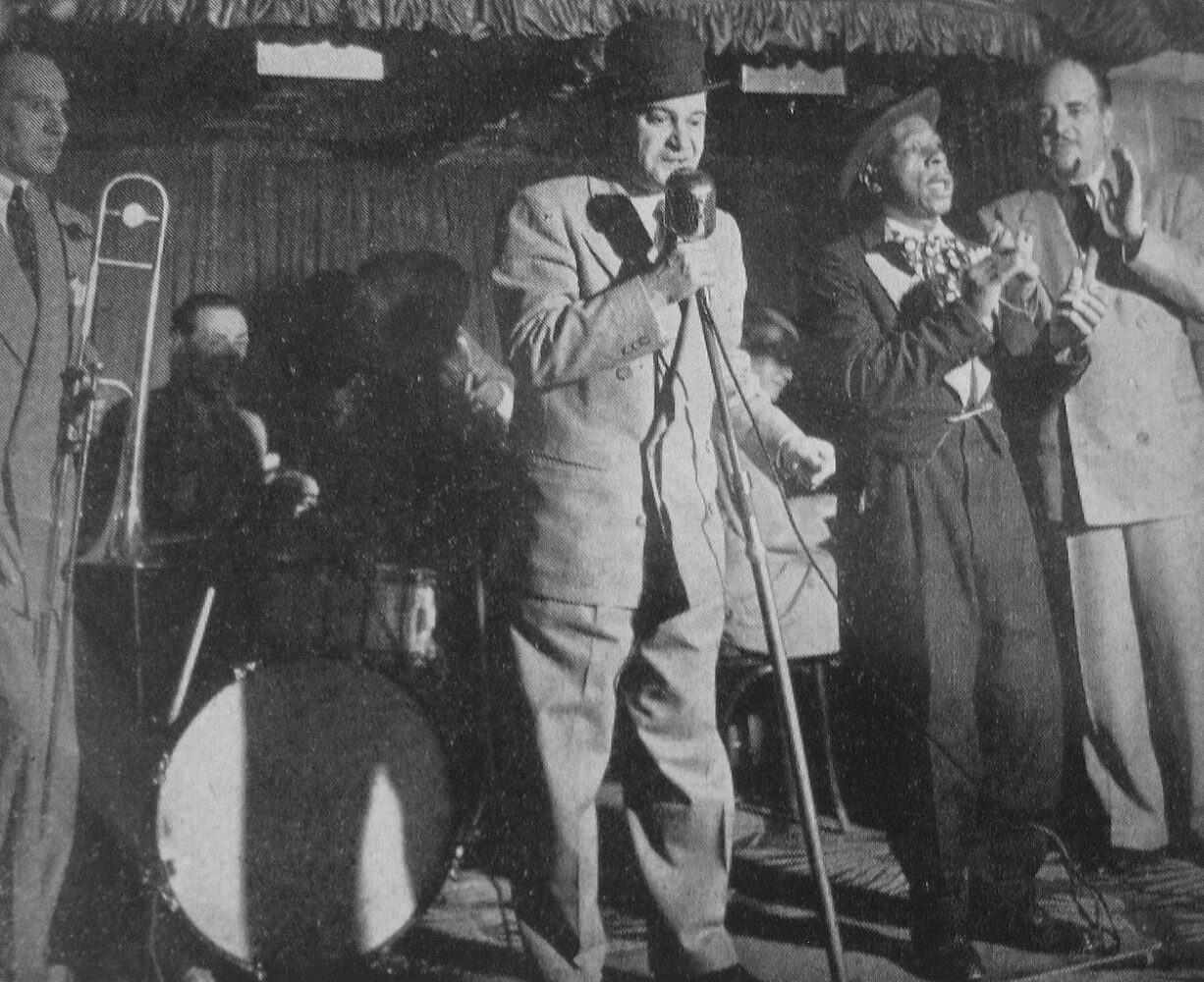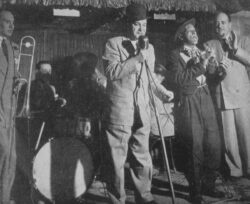Fall 2007
Jazz at the Lakefront
Lake Pontchartrain’s shore was an early jazz locus
Published: June 16, 2022
Last Updated: August 11, 2022

Photo by Stanley Kubrick for Look Magazine, Wikimedia Commons
Sharkey Bonano & band on stage in New Orleans, 1950.
Bluesman Richard “Rabbit” Brown, a street musician from the Storyville District who expanded his territory to cover Lake Pontchartrain, played guitar and sang at Mama Lou’s in Orange, near Little Woods. For a fee he would also take customers out onto the lake, singing as he rowed. (Talk about a captive audience!) In 1927 Brown recorded “The Ballad of the Titanic,” and one wonders how often he selected that number for his floating excursions. When business was slow and he needed a ride back to town, Brown would call in a false fire alarm. The firemen answering the call would soon discover that it was only their old friend, who was then expected to serenade them on the return trip to the station to make amends.
Most New Orleans jazz musicians had to travel to the lakefront resorts, but some were actually raised there. Trumpeter Joseph “Sharkey” Bonano grew up in Milneburg at his brother-in-law’s dance hall, Quarrella’s Pavilion. John Quarrella was known as “the Mayor of Milneburg” because he had the pavilion, a confectionary, a grocery store, a butcher stand, and various other interests there. His dance pavilion and cottages were located right over the water on a boardwalk extending from the village of Milneburg to the end of the pier, which was marked by a lighthouse. The train from town, “Smokey Mary,” ran right by the pavilion, which was situated in the center of the two-mile long boardwalk. Bonano remembered that there was music at Milneburg just about every day, but especially during weekends. Places such as the Owl Club, the Little Brown Jug, the Hazel Club, the Log Cabin, and Sam’s Camp offered picnics and dancing for a cover charge of a dollar and a half. Sharkey learned to play cornet while working at his brother-in-law’s bathhouse, practicing when he wasn’t picking up swimsuits. In 1918, Frank Christian’s band was performing at the pavilion, but when Christian left for New York to join Jimmy Durante’s Band, Quarrella suggested that Sharkey replace him as cornetist, largely because he wouldn’t have to pay a resident in-law. Bonano later became a bandleader and went to New York himself, where he recorded “Mudhole Blues” in 1936 (sounds like a reference to Lake Pontchartrain to me).
Even closer to the mark was a rendition of “Milneburg Joys,” recorded by Sharkey in New Orleans in 1949. This classic jazz tune was originally co-composed by Jelly Roll Morton (a Creole of color) and members of the New Orleans Rhythm Kings, Paul Mares and Leon Roppolo (who were white) at a July 1923 recording session for Gennett Records in Richmond, Indiana. In those days the Ku Klux Klan was a dominant force in Indiana, and since Gennett was known to make promotional records for the Klan, a racially integrated jazz session at their studio was pretty risky. George Brunies, the trombonist with the Rhythm Kings, later explained that the band passed Morton off to company officials as a “Spaniard” and when questioned about it, pointed to the diamond inlay in his tooth as proof positive, after which there was no argument. For the New Orleans musicians, however, the collaboration made perfect sense because they spoke the same musical language, despite differences of race. True to its name, “Milneburg Joys” recalls the relaxed ambience of the lakefront scene, where white and Black bands played within earshot of each other on Sunday afternoons. Drummer Paul Barbarin described it: “Maybe two camps away there would be a white band. Don’t think we didn’t have many great white jazz musicians in those days. We had ‘em. And they played great. But there was honest musical rivalry.” “Milneburg Joys” is a case in point: Morton later admitted that his only real contribution to the piece had been the introduction, but then added: “Of course, the rest don’t amount to much . . . ”
During its almost 100-year heyday, the lakefront had something for everyone, until the construction of a seawall and landfill projects erased this thriving music scene after 1927. Some say that all the trash from the camps washing up on Lincoln Beach became a pretext for demolition of the resorts, but more likely it was the lure of dollars generated by building new housing on the landfill that killed the lakefront scene. Whatever the reason, that reality has not been entirely lost—you can still hear it in Louis Armstrong’s version of “West End Blues” or Jelly Roll Morton’s “Bucktown Stomp.” All you have to do is close your eyes, listen, and pretend you’re at the lake.
Bruce Boyd Raeburn, PhD, is a former director of the Hogan Jazz Archive at Tulane University.
